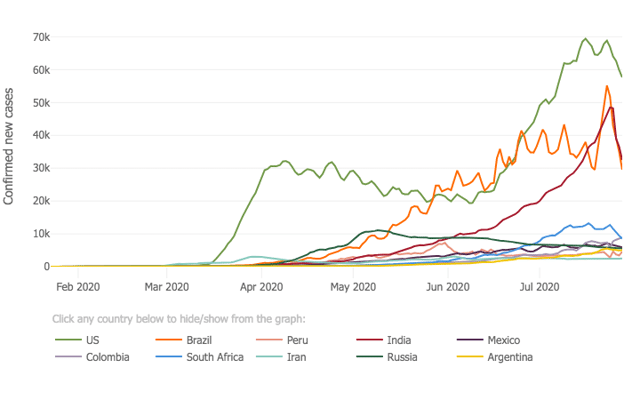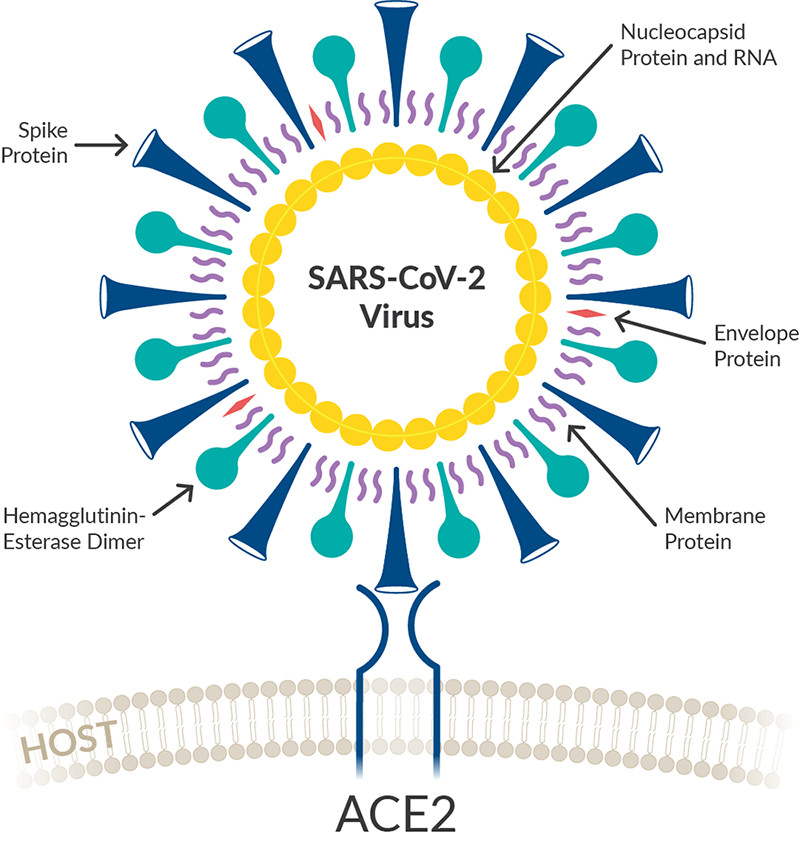What is ACE-2 Receptor, How it is Connected with SARS-CoV-2, and How Do We Know SARS-CoV-2 Uses ACE-2 Receptor for Entering the Host Cell?

Graph showing global daily confirmed new cases of COVID-19. Last updated on July 29, 2020, 03:00 AM EDT. Source: John Hopkins University
Long been coronavirus, the virus that causes COVID-19, has been a hot and ramping issue all over the world. Though some international biopharmaceuticals like Moderna, Oxford’s COVID-19 vaccine center, and Sinovac are almost in their last stage of trials, it can not be exactly said when the vaccine will be ready and the world will get it.
Globally, as of 7:24 pm CEST, 27 July 2020, 16,114,449 confirmed cases of COVID-19, including 646,641 deaths were reported to WHO, the USA being on top both in case of total cases and total deaths.
Whenever you heard/read news about the vaccine or antidote of COVId-19, you must have also heard/read that the vaccine/antidote is being specially designed to inhibit virus to enter through the ACE-2 receptor but you may be unaware what is ACE-2 receptor and why researchers are being so much focused on ACE-2 receptor? Here is the answer.
What is ACE-2 Receptor?
ACE-2 receptor, called angiotensin-converting enzyme 2, is an enzyme that is attached to the cell membranes mostly in the lungs, arteries, heart, kidney, and also in intestines and by study, it has been found that this protein receptor provides the entry point for the coronavirus to hook into and infect a wide range of human cells. So, if the virus enters through this receptor to the host cell then why our body needs this? Why don’t we just eliminate the ACE-2 receptor?
The answer is ACE-2 not only provide path to the coronavirus but also is a protein on the surface of many cell types and by cutting up the larger protein angiotensinogen, it generates small proteins that then go on to regulate functions in the cell so we basically need this to regulate the cell functions and can’t just eliminate.
The human version of ACE-2 is sometimes referred as hACE-2.
Additionally, ACE-2 is a vital element in a biochemical pathway that is critical in regulating processes such as blood pressure, wound healing, and inflammation.
How is the ACE-2 receptor linked to SARs-CoV-2?
The coronaviral genome encodes four major structural proteins: the spike (S) protein, nucleocapsid (N) protein, membrane (M) protein, and the envelope (E) protein. Using the spike protein (spike-protein) present on its surface the virus enters into the host cell. This phenomenon is exactly similar to a key being inserted into a lock. Hence, ACE-2 acts as a cellular doorway - a receptor (so-called as ACE-2 receptor)- for the virus that causes COVID-19, and this the point where COVID-19 vaccine researchers are trying to hit. They consider, if we can resist the coronavirus and stop them from bonding with the ACE-2 respirator then we can automatically get rid of the COVID-19. The idea is simply simple and seems logical but remaining will be evidenced in the near future.

It is still unclear if the number of ACE-2 receptors present determines whether someone gets more or less sick soo is the precise relationship between ACE-2 levels, viral infectivity, and severity of the infection. Though this also depends on the immunity response of the host cell, in my view, this will somehow affect, intuitively. As the coronavirus requires ACE-2 receptor to enter the host cell: more the number of entry doors, more the number of viruses that will get a chance to enter.
How do we know SARS-CoV-2 uses ACE-2 receptor?
Researchers identified that the virus responsible for COVID-19 (then named novel coronavirus) shared almost 88% sequence identity with two bat-derived SARS-like CoV, suggesting it had originated in bats. Additionally, it was shown that this CoV, which was termed 2019-nCoV or SARS-CoV-2, shared 79.5% sequence identity with SARS-CoV. Sequence analysis of the SARS-CoV-2 S protein genome showed that it was only 75% identical with the SARS-CoV S protein. However, analysis of the receptor-binding motif (RBM) in the S protein showed that most of the amino acid residues essential for receptor binding were conserved between SARS-CoV and SARS-CoV-2, suggesting that the 2 CoV strains use the same host receptor for cell entry.
